Tibet Travel offers an unforgettable experience, and SIXT.VN is here to make your journey seamless and stress-free. Planning a trip to Tibet might seem daunting, but with the right guidance, you can explore this mystical land with ease, ensuring a memorable adventure filled with cultural immersion and breathtaking landscapes. Let’s explore how to plan your travel.
1. Top Tibet Travel Questions Answered
Embarking on a Tibet travel adventure raises many questions. Here are answers to ten frequently asked questions to kickstart your planning:
1.1. Is Tibet Open To Tourists?
Yes, Tibet is generally open to tourists, however, it is important to note that there are specific periods, usually around February and March, when it is closed. According to the Tibet Tourism Bureau, the region typically reopens to international travelers in early April. To enter, you need a Chinese visa and a Tibet Travel Permit. Check for current travel advisories before planning your trip.
1.2. Can You Travel Independently In Tibet?
Unfortunately, independent travel in the Tibet Autonomous Region (TAR) is not allowed. You must join an organized tour with a certified Tibet travel agency. However, the good news is that you can opt for a private tour with just you and your chosen companions. In areas outside the TAR, such as Kham and Amdo, independent travel is permitted.
1.3. Is It Safe To Travel To Tibet?
Tibet is considered a safe destination for travelers. Personal security is generally high, and many visitors feel safer there than in their home countries. It’s worth noting that solo travel within Tibet requires a guide and driver, although you can explore certain areas of Lhasa on your own.
1.4. How To Avoid Altitude Sickness?
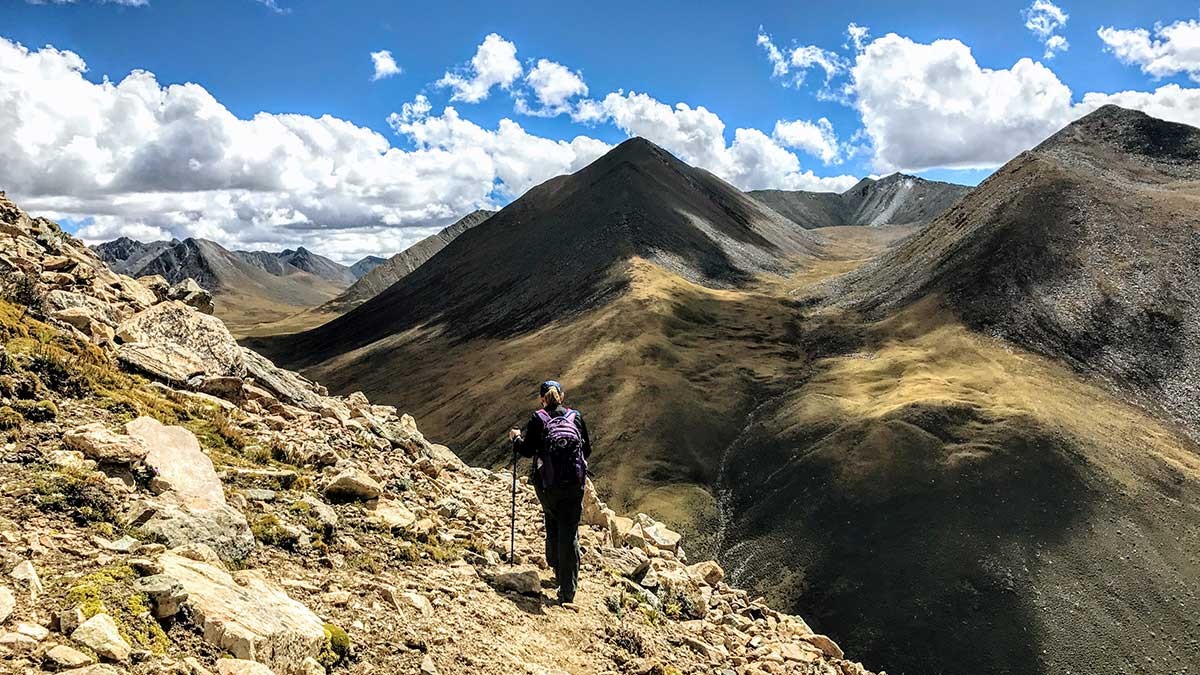 Yolanda coming down from the Zhugar La Pass (17,224 ft/5250 m) on the Ganden Samye Trek in TibetYolanda coming down from the Zhugar La Pass (17,224 ft/5250 m)
Yolanda coming down from the Zhugar La Pass (17,224 ft/5250 m) on the Ganden Samye Trek in TibetYolanda coming down from the Zhugar La Pass (17,224 ft/5250 m)
Altitude sickness is a significant concern due to Tibet’s high average elevation of 4,500 meters (14,750 ft). To prevent it, consider these steps:
- Spend a couple of nights at an intermediate elevation, like Xining, before heading to Lhasa.
- Take the train to Lhasa from Xining to allow gradual acclimatization.
- Consult your doctor about Diamox, a medication that can help prevent altitude sickness.
- Rest for several days upon arriving in Lhasa to acclimatize to the altitude.
- Follow basic acclimatization rules when ascending to higher elevations.
1.5. When Is The Best Time To Visit Tibet?
Each season offers unique advantages and disadvantages. Summer provides lush greenery and warm temperatures but can be crowded and rainy. Fall and spring are colder but less crowded with clearer skies. Winter offers the fewest tourists, cheaper prices, and a unique cultural atmosphere with Tibetan pilgrims flocking to Lhasa. Avoid February and March due to closures and Chinese national holidays due to large crowds.
1.6. Can I Go To Tibet With A Chinese Visa?
Yes, a Chinese visa is required, but it’s not enough on its own. You also need a Tibet Travel Permit issued by the Chinese government through a certified Tibet travel agency. To obtain the permit, you must book a tour with a certified agency that will handle the application process for you.
1.7. How Much Does It Cost To Travel To Tibet?
Traveling to Tibet is generally not cheap due to various policies and restrictions imposed by the Chinese government. According to recent data, a 4-day Lhasa Highlights tour can cost between $450 and $560 per person for small group travel. Private tours can be more expensive, but going in winter, joining a group, or sharing a room can help save money.
1.8. Is Lhasa Worth Visiting?
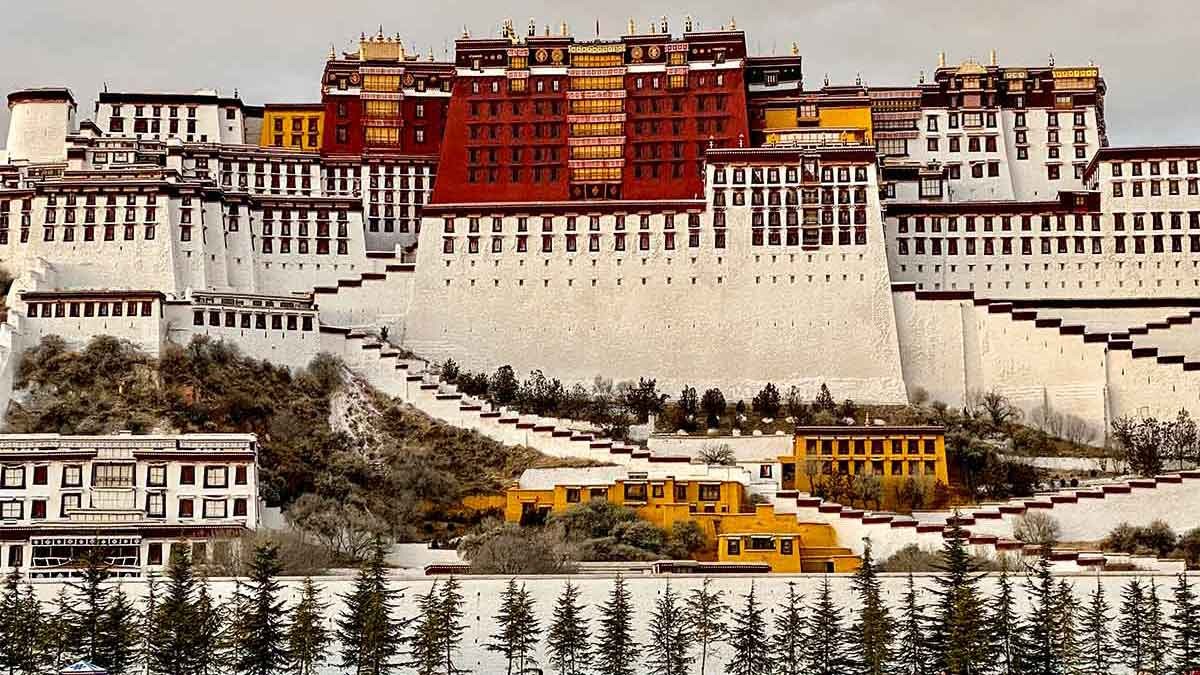 Travel Tibet: Potala Place in Winter
Travel Tibet: Potala Place in Winter
Lhasa is undoubtedly worth visiting. The city is filled with cultural and spiritual treasures, such as the Potala Palace and Jokhang Temple. Experiencing the devotion of Tibetan pilgrims and sharing butter tea with locals makes Lhasa an unforgettable destination.
1.9. Can You Travel To Tibet From Nepal?
Yes, you can travel to Tibet from Nepal, preferably by flying rather than traveling overland to minimize the risk of altitude sickness. When entering from Nepal, you need a “Tibet Group Visa” from an authorized Nepali travel agency, which will cancel any other Chinese visas you hold.
1.10. Where Is Tibet?
Tibet is located in the heart of Asia, between mainland China and India. The Tibetan Plateau borders Nepal, Bhutan, Burma, mainland China, and Xinjiang. To enter the Tibet Autonomous Region, you need a special Tibet Travel Permit in addition to your visa.
2. Must-See Places In Tibet
Tibet is a vast region filled with stunning sights and experiences. Here are some of the must-see places to include in your itinerary:
2.1. What Is Tibet Famous For?
Tibet is renowned for its towering mountains, stunning monasteries, serene lakes, and unique culture. The region offers a spiritual and visual feast, with sights like Mount Everest, Mount Kailash, and the Jokhang Temple.
2.1.1. Tibet Mountains
The Himalayas and other great ranges define the Tibetan Plateau, offering breathtaking views and spiritual significance.
2.1.2. Tibetan Buddhist Monasteries And Temples
 Jokhang Temple Roof in Lhasa, Tibet
Jokhang Temple Roof in Lhasa, Tibet
These sacred sites showcase Tibetan Buddhist practices and stunning architecture.
2.1.3. Sky Lakes
Some of the world’s highest and most beautiful lakes are found in Tibet, offering serene and breathtaking vistas.
2.1.4. Tibetan People
The kindness, resilience, and quick wit of the Tibetan people make them unforgettable.
2.2. Important Places In Tibet
Here are three of the most significant and popular tourist attractions in Tibet:
2.2.1. Lhasa
The ancient capital of Tibet, home to the Jokhang Temple and Potala Palace, offers a unique cultural experience.
2.2.2. Mount Everest
 Mount Everest from Rongbuk Monastery.
Mount Everest from Rongbuk Monastery.
The greatest views of the world’s highest mountain can be found at Everest Base Camp on the Tibet side.
2.2.3. Mount Kailash
Sacred to four religions, this mountain is a popular pilgrimage site and offers a transformative spiritual journey.
2.3. Things To Do In Tibet
Given the need to join an official tour to visit Tibet, here are some of the top Tibet tours you can consider:
2.3.1. Sky Train To Lhasa (7 Days)
Combining the unique Tibet train journey with a tour of Lhasa highlights is an excellent way to see the landscape and treasures.
2.3.2. Lhasa Highlights Tour (4 Days)
Fly into Lhasa and experience the most famous Tibetan cultural and spiritual treasures.
2.3.3. Everest Base Camp Tibet
A journey from Lhasa to Mount Everest offers a chance to see dazzling highlights.
2.3.4. Mount Kailash Tour
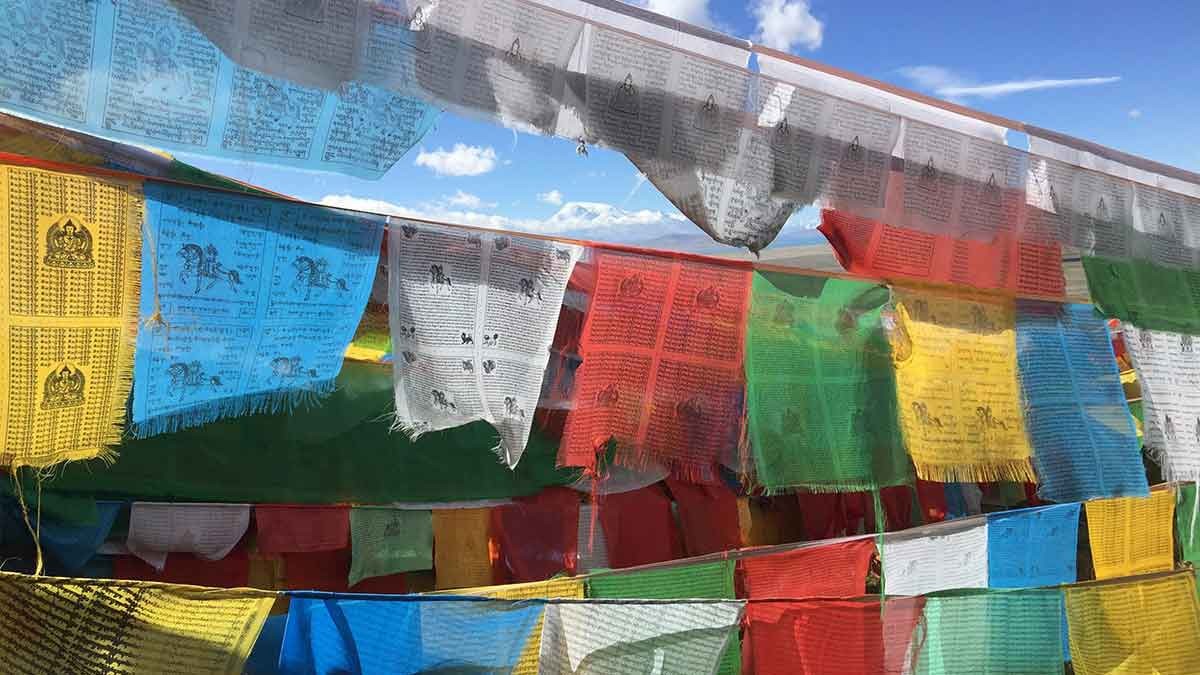 Trip to Kailash: Prayer Flags in the Foothills of Mt Kailash
Trip to Kailash: Prayer Flags in the Foothills of Mt Kailash
This tour includes Lhasa, Shigatse, Gyantse, Everest Base Camp, and a trek around Mount Kailash.
2.3.5. Overland From Lhasa To Kathmandu
Travel from Lhasa to Kathmandu, experiencing the highlights of Lhasa, turquoise lakes, and Everest Base Camp.
3. How To Go To Tibet
Getting to Tibet involves a few steps due to travel restrictions. However, the process is manageable with proper planning.
3.1. Can You Visit Tibet Independently?
Due to government restrictions, independent travel is not permitted. You must be part of an organized tour with a Tibet travel agency.
3.2. Recommended Travel Route
A recommended route is to fly to China, then fly to Xining, and finally take the train to Lhasa. This minimizes the risk of altitude sickness while providing a unique experience.
3.3. How To Get To Tibet From China
From mainland China, you can enter Tibet by train or air.
3.3.1. By Tibet Train
 View from Tibet train in Nagchu Area.
View from Tibet train in Nagchu Area.
Trains from all over China connect to the Qinghai Tibet Railway in Xining. This allows for a gradual altitude adjustment, though starting from Beijing, Shanghai, or Chengdu is not recommended.
3.3.2. By Air
Many cities in China offer flights to Tibet. While you can fly directly to Lhasa, it increases the risk of altitude sickness.
3.4. Can You Travel To Tibet From Nepal?
Yes, you can travel to Tibet from Nepal. Direct flights are available, but keep in mind that you will need a special group visa, which may impact your future travel in China.
3.4.1. Kathmandu To Lhasa Flight
Entering Tibet from Nepal requires a special group visa that may affect future travel in China. It’s essential to have at least five people in your group to apply for the group visa.
3.4.2. Overland: Via Friendship Highway
Traveling overland is not recommended due to insufficient time for acclimatization and rough road conditions.
4. Best Time To Visit Tibet
Determining the best time to visit Tibet depends on your preferences regarding weather, crowds, and budget.
4.1. General Recommendations
Fall and winter (mid-October to mid-January) offer fewer crowds and clear weather. Late spring and early summer (mid to late April through early June) are also favorable.
4.2. What Is The Weather In Tibet?
Tibetan weather varies significantly by season and microclimate.
4.2.1. Summer
Mild weather with rain, green landscapes, and the highest tourist season.
4.2.2. Fall
 Tibetan Ladies after a prayer at Dzogchen Monastery
Tibetan Ladies after a prayer at Dzogchen Monastery
Mild weather transitioning to colder temperatures, fewer tourists after early October.
4.2.3. Winter
Cold, clear weather with excellent local atmosphere and the lowest tourist season.
4.2.4. Spring
Warming temperatures, increasing tourism, and a good time to visit Kham or Amdo.
4.3. Best Time To Visit Lhasa Tibet
Visiting Lhasa is possible year-round, with fall and mid-winter being particularly enjoyable. The tourism industry generally recommends April to November.
4.4. Best Time To Visit Everest Base Camp Tibet
 View of Mount Everest from Everest Base Camp and Rongbuk Monastery
View of Mount Everest from Everest Base Camp and Rongbuk Monastery
April, May, and October are ideal for visiting Everest Base Camp, offering clear skies.
4.5. Best Time To Visit Mount Kailash
Tours to Mount Kailash typically run from May to September, with May and September offering the best chance of clear views.
5. How To Get Your Visa And Tibet Travel Permit
Acquiring the necessary travel documents for Tibet is straightforward.
5.1. How To Get A Chinese Visa
Apply for a Chinese visa in your home country through the nearest Chinese embassy or consulate.
5.2. How Do I Apply For A Tibet Travel Permit?
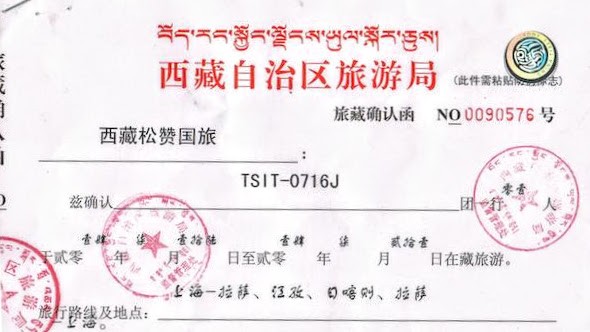 Tibet Travel Permit
Tibet Travel Permit
Your Tibet travel agency will obtain the Tibet Travel Permit for you once you book a tour.
6. Staying Healthy And Safe When You Visit Tibet
Ensuring your health and safety is paramount when traveling to Tibet.
6.1. Altitude Sickness Prevention
Ascending slowly is crucial to avoid altitude sickness. Consider flying to Xining, spending a few nights there, and then taking the train to Lhasa.
6.2. Personal Security
Tibet is generally a safe place. Rely on your guide and driver to ensure your safety.
6.3. Driving In Tibet
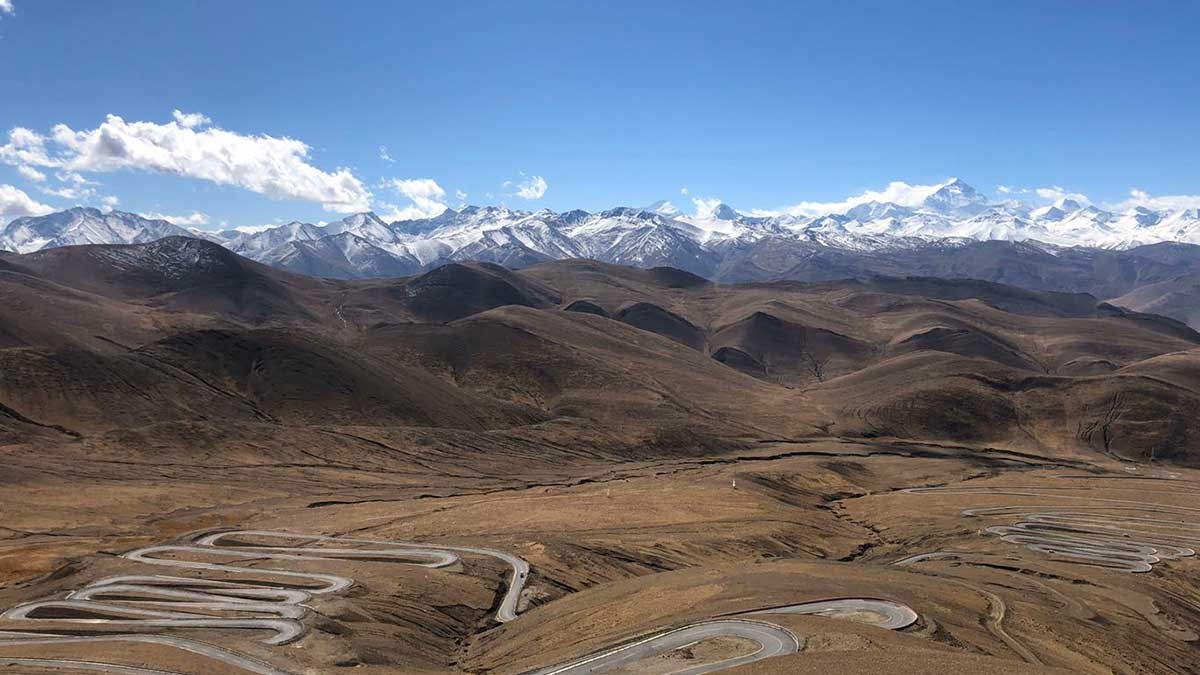 View from Gyawo la Pass in the Mount Everest Region on the Tibet side
View from Gyawo la Pass in the Mount Everest Region on the Tibet side
Ensure your driver is not tired or driving unsafely.
6.4. Keep Your Stomach Happy
Eat freshly cooked food and drink bottled or boiled water.
6.5. Protect Your Skin
Use sunscreen, a wide-brimmed hat, and a face mask to protect your skin from high UV radiation.
6.6. Tibet Travel Insurance
Get comprehensive travel insurance that covers emergency medical evacuation and trip cancellations.
7. Tibetan Food
Explore the unique flavors of Tibetan cuisine.
7.1. Best Tibetan Dishes
Some popular dishes include momos (dumplings), thenthuk (noodle soup), and shapaley (fried meat pies).
7.2. What Is Tibetan Food, Anyway?
 Pa: Tibetan tsampa dish made with tsampa, butter tea, dried cheese and sometimes sugar.
Pa: Tibetan tsampa dish made with tsampa, butter tea, dried cheese and sometimes sugar.
Traditional staples include tsampa (roasted barley flour), butter tea, and yak-related meat and dairy products.
7.3. Where To Eat
Favor Tibetan-owned restaurants and shops.
7.4. Practice Your Own Traditional Tibetan Food Recipes Before You Go
Consider trying out Tibetan recipes before your trip.
8. Where To Stay When You Visit Tibet
Accommodation in Tibet is generally satisfactory.
8.1. Best Hotels In Lhasa Tibet
In Lhasa, opt for Tibetan-owned hotels.
8.1.1. Mid-Range
Consider the Kyichu Hotel, Shang Bala Hotel, or Dekhang Hotel.
8.2. Where To Stay Outside Lhasa
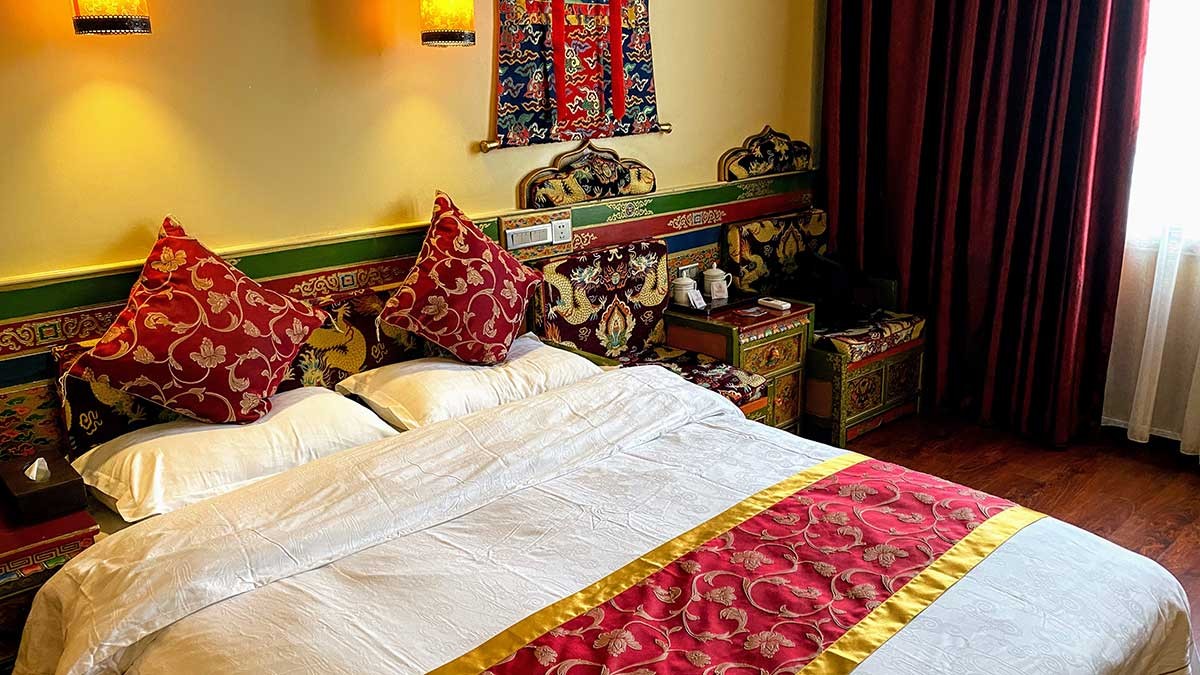 Gesar Hotel in Shigatse, Tibet
Gesar Hotel in Shigatse, Tibet
In Shigatse, the Gesar Hotel is a good choice. In Gyantse, the Yeti Hotel is recommended.
9. Top Recommendations
Here are some top Tibet travel tips:
9.1. Book With A High-Quality Tibetan-Owned Agency
Choose a reliable Tibetan-owned agency to support the local community and receive better care.
9.2. Book A Tour That Will Make The Most Of Your Time In Tibet
Select tours that align with your interests and time frame.
9.3. Use A Packing List For Tibet Travel
 Visit Tibet: Packing List
Visit Tibet: Packing List
Pack appropriately for Tibet’s unique climate and conditions.
9.4. Avoid Being An Ugly Tourist When You Visit Tibet
Respect Tibetan culture and etiquette.
9.5. Get Travel Insurance
Secure comprehensive travel insurance.
9.6. Read And Learn Before You Go
Gain a basic understanding of Tibet’s history and culture.
9.7. Watch And Learn Before You Visit Tibet
Watch movies and documentaries about Tibet.
9.8. Don’t Leave It To The Last Minute
Start planning your visit well in advance due to permit and visa requirements.
SIXT.VN is committed to making your Tibet travel experience exceptional. We offer tailored services to meet your needs, from airport transfers to hotel bookings, ensuring a hassle-free adventure.
10. FAQs About Tibet Travel
-
What is the best way to get to Lhasa?
The best way is to fly to Xining, spend a couple of nights there to acclimatize, and then take the train to Lhasa.
-
Can I extend my visa while in Tibet?
Visa extensions are generally not possible within Tibet. Ensure your visa covers your entire stay.
-
What should I pack for a trip to Tibet?
Pack warm layers, sunscreen, a hat, and comfortable walking shoes.
-
Are there ATMs in Lhasa?
Yes, ATMs are available in Lhasa, but it’s a good idea to carry some cash.
-
What languages are spoken in Tibet?
The primary languages are Tibetan and Mandarin Chinese.
Ready to explore Tibet? Let SIXT.VN handle the details. Contact us today for personalized travel advice and to book your unforgettable journey. Whether you need reliable airport transfers, comfortable hotel accommodations, or expertly guided tours, we’re here to ensure your trip is seamless and memorable. Visit SIXT.VN or call +84 986 244 358 now!



